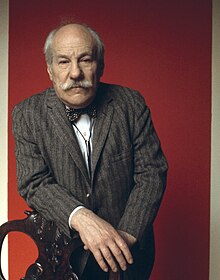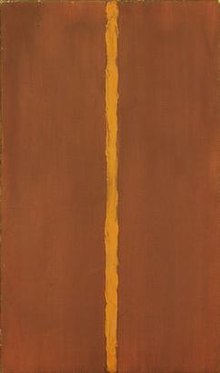*****
https://www.facebook.com/hanching.chung/videos/886395382269505
MoMA 難忘的邂逅:《人,英雄而崇高》The momentous simplicity of Barnett Newman’s painting "Vir Heroicus Sublimis." (1950-51)
******
The momentous simplicity of Barnett Newman | UNIQLO ARTSPEAKS
https://www.youtube.com/watch?v=eIf9f8Ju5so
The Latin title Vir Heroicus Sublimis can be translated “Man, heroic and sublime.” Newman once asked, “If we are living in a time without a legend that can be called sublime, how can we be creating sublime art?” This painting, his largest at the time, is one response. Newman wanted the viewer to stand close to this work, and he likened the experience to a human encounter: “It’s no different, really, from meeting another person. One has a reaction to the person physically. Also, there’s a metaphysical thing, and if a meeting of people is meaningful, it affects both their lives.”
拉丁文標題 Vir Heroicus Sublimis 可以翻譯為“人,英勇而崇高”。 紐曼曾問:“如果我們生活在一個沒有可稱為崇高的傳奇的時代,我們如何創造崇高的藝術?” 這幅畫是他當時最大的一幅畫,是一種回應。 紐曼希望觀眾站在這件作品附近,他將這種體驗比作人類的遭遇:“這與遇見另一個人沒有什麼不同。 一個人對人的身體有反應。 此外,還有一個形而上學的東西,如果人們的會議有意義,它會影響他們的生活。”
Barnett Newman
Barnett Newman | |
|---|---|
 Newman c. 1969 | |
| Born | January 29, 1905 |
| Died | July 4, 1970 (aged 65) New York City |
| Nationality | American |
| Known for | Painting, Sculpture |
Notable work | The Stations of the Cross, Vir heroicus sublimis |
| Movement | Abstract expressionism, color field painting |
Barnett Newman (January 29, 1905 – July 4, 1970) was an American artist. He is seen as one of the major figures in abstract expressionism and one of the foremost of the color field painters. His paintings are existential in tone and content, explicitly composed with the intention of communicating a sense of locality, presence, and contingency.[1]
Early life[edit]
Barnett Newman was born in New York City, the son of Jewish immigrants from Poland. He studied philosophy at the City College of New York and worked in his father's business manufacturing clothing. He later made a living as a teacher, writer, and critic.[2] From the 1930s on he made paintings, said to be in an expressionist style, but eventually destroyed all these works. Newman met Annalee Greenhouse in 1934, while both were working as substitute teachers at Grover Cleveland High School; they were married on June 30, 1936.[3]
Career[edit]
Newman wrote catalogue forewords and reviews and also organized exhibitions before becoming a member of the Uptown Group and having his first solo show at the Betty Parsons Gallery in 1948. Soon after his first exhibition, Newman remarked in one of the Artists' Session at Studio 35: "We are in the process of making the world, to a certain extent, in our own image."[5] Utilizing his writing skills, Newman fought to reinforce his newly established image as an artist and to promote his work. An example is his letter on April 9, 1955, "Letter to Sidney Janis: ... it is true that Rothko talks the fighter. He fights, however, to submit to the philistine world. My struggle against bourgeois society has involved the total rejection of it."[6]
Throughout the 1940s he worked in a surrealist vein before developing his mature style. This is characterized by areas of color separated by thin vertical lines, or "zips" as Newman called them. In the first works featuring zips, the color fields are variegated, but later the colors are pure and flat. Newman himself thought that he reached his fully mature style with the Onement series (from 1948). The zips define the spatial structure of the painting, while simultaneously dividing and uniting the composition. Already 1944 Barnett Newman tried to explain America's newest art movement and included a list of "the men in the new movement." Ex-Surrealists, like Matta are mentioned, Wolfgang Paalen Paalen is mentioned twice together with Gottlieb, Rothko, Pollock, Hofmann, Baziotes, Gorky and others. Motherwell is mentioned with a question mark.[7] The zip remained a constant feature of Newman's work throughout his life. In some paintings of the 1950s, such as The Wild, which is eight feet tall by one and a half inches wide (2.43 meters by 4.1 centimeters), the zip is all there is to the work. Newman also made a few sculptures which are essentially three-dimensional zips.[8]:511
Although Newman's paintings appear to be purely abstract, and many of them were originally untitled, the names he later gave them hinted at specific subjects being addressed, often with a Jewish theme. Two paintings from the early 1950s, for example, are called Adam and Eve. There is also Uriel (1954), and Abraham (1949), a very dark painting which, as well as being the name of a biblical patriarch, was also the name of Newman's father, who had died in 1947.
The Stations of the Cross series of black and white paintings (1958–1966), begun shortly after Newman had recovered from a heart attack, is usually regarded as the peak of his achievement. The series is subtitled Lema sabachthani - "Why have you forsaken me" - the last words spoken by Jesus on the cross, according to the New Testament. Newman saw these words as having universal significance in his own time. The series has also been seen as a memorial to the victims of the Holocaust.[9]
Newman's late works, such as the Who's Afraid of Red, Yellow and Blue series, use vibrant, pure colors, often on very large canvases - Anna's Light (1968), named in memory of his mother, who had died in 1965, is his largest work, 28 feet wide by 9 feet tall (8.5 by 2.7 meters). Newman also worked on shaped canvases late in life, with Chartres (1969), for example, being triangular, and returned to sculpture, making a small number of sleek pieces in steel. These later paintings are executed in acrylic paint rather than the oil paint of earlier pieces. Of his sculptures, Broken Obelisk (1963) is the most monumental and best-known, depicting an inverted obelisk whose point balances on the apex of a pyramid.
Newman also made a series of lithographs, the 18 Cantos (1963–64) which, according to Newman, are meant to be evocative of music. He also made a small number of etchings.
In 1948, Newman, William Baziotes, Mark Rothko, Robert Motherwell and David Hare founded the Subjects of the Artist School at 35 East 8th Street. Well attended lectures there were open to the public, with speakers such as Jean Arp, John Cage and Ad Reinhardt, but the art school failed financially and closed in the spring of 1949.[10][11][12] Newman is generally classified as an abstract expressionist on account of his working in New York City in the 1950s, associating with other artists of the group and developing an abstract style which owed little or nothing to European art. However, his rejection of the expressive brushwork employed by other abstract expressionists such as Clyfford Still and Mark Rothko, and his use of hard-edged areas of flat color, can be seen as a precursor to post painterly abstraction and the minimalist works of artists such as Frank Stella.
Newman was unappreciated as an artist for much of his life, being overlooked in favor of more colorful characters such as Jackson Pollock. The influential critic Clement Greenberg wrote enthusiastically about him, but it was not until the end of his life that he began to be taken seriously. He was, however, an important influence on many younger artists such as Donald Judd, Frank Stella and Bob Law.[8]:512




沒有留言:
張貼留言